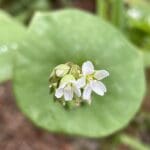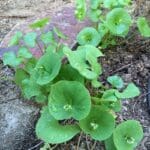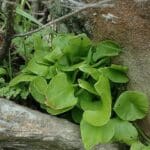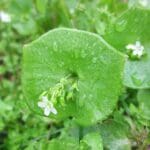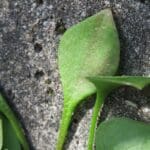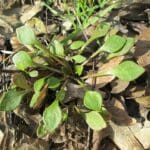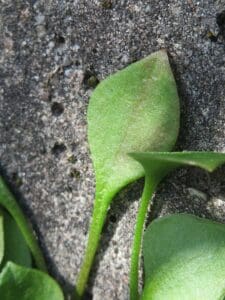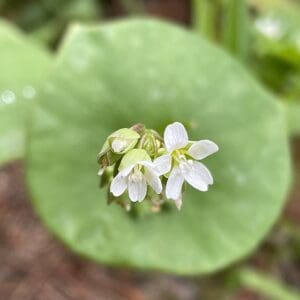Miners Lettuce / Spring / Summer / Winter / Edible
Common Names
Miner’s lettuce, Indian lettuce, Spring Beauty, Winter Purslane.
Botanical Name
Claytonia perfoliata
Scientific Classification
Kingdom – Plantae
Order –Caryophyllales
Family – Montiaceae
Physical Characteristics for Miner’s lettuce
Claytonia perfoliata is a tender rosette-forming plant that grows to a maximum of 40 centimetres (16 in) in height, but mature plants can be as short as 1 centimetre (0.39 in).
Leaves
The cotyledons are usually bright green (rarely purplish- or brownish-green), succulent, long and narrow. The first true leaves form a rosette at the base of the plant, and are 0.5 to 4 centimetres (0.20 to 1.57 in) long, with a typically long petiole (exceptionally up to 20 centimetres (7.9 in) long).
As the days get hotter and drier, the leaves turn a deep red colour as they dry out.
Flowers
The small pink or white flowers have five petals 2 to 6 millimetres (0.079 to 0.236 in) long. The flowers appear from February to May or June, and are grouped 5–40 together. The flowers grow above a pair of leaves that are connected together around the stem so as to appear as a single circular leaf. Mature plants form a rosette; they have numerous erect to spreading stems that branch from the base.
Fruit
Fruits are tiny, three-valved capsules containing one to three round to egg-shaped, shiny, black seeds.
Habitat
Disturbed and waste ground, moist banks and slopes, often in partial shade, especially on light soils. Also found on rather dry sandy soils. Western N. America – British Columbia to California and Mexico. Naturalised in Britain. C. perfoliata is common in the springtime, and prefers a cool, damp environment. The plant first appears in sunlit areas after the first heavy rains of the year, though the best stands are found in shaded areas, especially in the uplands, into early summer.
Known Hazards
None known
Could be Confused with
It could be confused with the closely related Pink Purslane (Claytonia sibirica) that is again a lovely edible salad plant. This has much larger pink flowers with notches in the tips of the petals, and without the collar of leaves.
Edible Uses
- Leaves – raw or cooked. A fairly bland flavour with a mucilaginous texture, it is quite nice in a salad. The young leaves are best, older leaves can turn bitter especially in the summer and if the plant is growing in a hot dry position. Although individual leaves are fairly small, they are produced in abundance and are easily picked.
- Stalks and flowers – raw. A nice addition to the salad bowl
- Bulb – raw. Although very small and labour-intensive to harvest, the boiled and peeled root has the flavour of chestnuts.
The leaves appear in abundance in March and April. Cut or pull the stems and rinse. Or, carefully dig up the bulbs (making sure that they are attached to the correct plants.
Notes on Herbal uses
The leaves are gently laxative. Apart from its value as a nourishing vegetable that is rich in vitamin C, it can also be taken as an invigorating spring tonic and an effective diuretic. A poultice of the mashed plants has been applied to rheumatic joints
Extra notes from the Foragers
The common name of Miner’s Lettuce refers to how the plant was used by miners during the California Gold Rush, who ate it to prevent scurvy.



